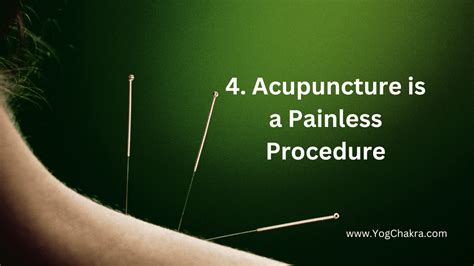Acupuncture, an ancient practice originating from traditional Chinese medicine, has been increasingly recognized for its potential in addressing a wide range of health issues, from chronic pain and migraines to stress and digestive problems. Despite its growing popularity, many potential beneficiaries are deterred by the misconception that acupuncture is painful. The truth is, when properly administered, acupuncture can be a virtually painless experience. Here are eight secrets to ensure your acupuncture sessions are not only effective but also comfortable and painless.
Understanding Acupuncture Basics
First and foremost, it’s essential to understand the basics of acupuncture. This practice involves the insertion of very thin needles into strategic points on the body. It’s based on the premise that the flow of energy (qi) in the body can be restored or balanced by stimulating these points, thereby promoting health and well-being. The fear of pain often stems from misconceptions about the size and sensation of the needles, as well as the technique used for their insertion.
Choosing the Right Practitioner
The skill and experience of the practitioner play a significant role in ensuring a painless experience. A well-trained and experienced acupuncturist knows exactly how to insert the needles to minimize discomfort. They understand the anatomy and can choose the right needles and techniques for each individual’s needs. When selecting a practitioner, look for certifications from reputable organizations and read reviews from previous clients to get an idea of their expertise and bedside manner.
Preparing for Your Session
Preparation is key to a comfortable experience. Ensuring you’re well-rested, have eaten a light meal, and are hydrated can significantly reduce any potential discomfort. Avoid consuming heavy meals or alcohol before the session, as this can make you feel uncomfortable or lightheaded during the treatment. It’s also advisable to wear loose, comfortable clothing that allows easy access to the areas where the needles will be inserted.
Communication is Key
Open and honest communication with your practitioner is crucial. Before and during the session, let them know about any areas of discomfort or pain. Acupuncturists are trained to adjust their techniques based on feedback, so don’t hesitate to speak up. This not only helps in minimizing pain but also ensures that the treatment is as effective as possible.
Needle Quality Matters
The quality of the needles used can affect the level of discomfort experienced. High-quality, sterile, and disposable needles are designed to be as thin as possible, reducing the sensation of insertion. Additionally, some practitioners may use guidetubes to help inserts the needle, which can minimize discomfort. Ensure that your practitioner uses the best quality needles available.
Relaxation Techniques
Learning and practicing relaxation techniques can significantly reduce any anxiety or discomfort associated with acupuncture. Deep breathing exercises, progressive muscle relaxation, or meditation can help you relax, making the experience more comfortable. Some practitioners may also play soothing music or use aromatherapy to create a calming atmosphere.
Positioning and Support
The position of your body during the treatment can also impact your comfort level. Your practitioner should ensure that you’re in a comfortable position, with appropriate support if necessary. For example, cushions or pillows might be used to support your back or under your knees to reduce strain and ensure you’re as comfortable as possible throughout the session.
Follow-Up Care
Finally, understanding what to expect after the treatment can also contribute to a positive and painless experience. Your practitioner should provide you with guidelines on how to care for yourself post-treatment, including advice on rest, hydration, and any signs of reaction to watch out for. Following these guidelines can help minimize any side effects and ensure you get the most out of your acupuncture sessions.
Acupuncture is not just about inserting needles; it's a holistic approach to health that considers the physical, emotional, and mental well-being of an individual. With the right mindset, preparation, and care, it can be a highly effective and virtually painless method for achieving better health and quality of life.
Real Stories of Transformation
Many have found significant relief and improvement in their health through acupuncture, experiencing it as a painless and beneficial treatment. For instance, a patient suffering from migraines might find that regular acupuncture sessions not only reduce the frequency of their attacks but also minimize their discomfort during the sessions themselves. Another example could be someone dealing with anxiety, who, after starting acupuncture, reports feeling more grounded and less anxious during and after the sessions.
Addressing Common Concerns
- Q: Is acupuncture suitable for everyone?
A: While acupuncture can be beneficial for a wide range of conditions, it might not be suitable for everyone, particularly those with certain medical conditions or taking specific medications. Consultation with a healthcare provider before starting acupuncture is essential.
- Q: What if I’m afraid of needles?
A: Fear of needles is common, but acupuncture needles are very fine, and the sensation of insertion is often compared to a mild pinch, which is temporary. Communicating your fear with your practitioner can help them take extra steps to make you comfortable.
- Q: Can I stop the treatment if it hurts?
A: Yes, you’re in control. If at any point you experience discomfort, let your practitioner know. They can adjust the needles or stop the treatment as needed.
In conclusion, acupuncture, when approached with the right mindset and practitioner, can be a remarkably painless and beneficial experience. By understanding the basics, choosing the right practitioner, preparing properly, communicating openly, and embracing relaxation techniques, you can ensure that your acupuncture sessions are not only effective but also comfortable and virtually painless. As with any healthcare treatment, it’s essential to be informed, prepared, and open to the experience, allowing you to harness the full potential of acupuncture for your health and well-being.



